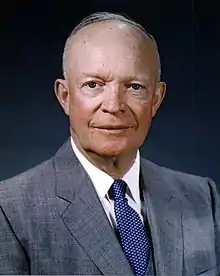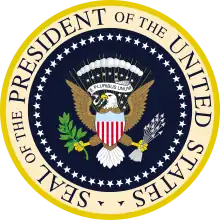Ike for President (advertisement)
"Ike for President", sometimes referred to as "We'll Take Ike" or "I Like Ike", was a political television advertisement for Dwight D. Eisenhower's 1952 presidential campaign.
The "Ike for President" advertisement (runtime 60 seconds) | |
| Client | Citizens for Eisenhower committee |
|---|---|
| Running time | 60 seconds |
| Release date(s) | 1952 |
| Production company | The Walt Disney Company |
| Produced by | Roy O. Disney |
| Country | United States |
In 1952, Eisenhower contested the election for the presidency of the United States as a Republican. He faced the Democratic candidate Adlai Stevenson II. Jacqueline Cochran, a pilot and Eisenhower campaign aide, coordinated with Roy O. Disney of The Walt Disney Company to create a minute-long animated advertisement produced by Disney volunteers. The advertisement begins with a bouncing "Ike" campaign button. Uncle Sam, dressed as a drum major, leads a parade, including a circus elephant, followed by a crowd of people with different occupations. Democratic vice presidential candidate John Sparkman, Secretary of State Dean Acheson, and President Harry S. Truman are depicted as Democratic donkeys. The spot's narrator concludes: "Now is the time for all good Americans to come to the aid of their country."[1]
The advertisement's memorable jingle turned "Ike for President" into a popular catchphrase. Author Thomas A. Hollihan said the jingle's main purpose was to achieve name recognition. Paul Christiansen considered the final line to be a "party-transcending appeal to voters."[1] Eisenhower's organization planned to broadcast the advertisement five to six times every night during the final two weeks of the campaign in a few targeted areas. Stevenson referred the commercial as the worst thing he ever heard. Eisenhower won the election in a landslide. Time magazine later ranked "Ike for President" eighth in its list of top-ten campaign advertisements.
Background
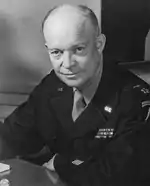
Dwight D. Eisenhower was the commander of the Allied Expeditionary Force in Europe during the World War II, and directed the 1944 Normandy invasion.[2][3] He was extremely popular; in the late 1940s, and he frequently topped the "most admired man" poll conducted by Gallup.[4][5] He served as the Chief of Staff of the Army from 1945 to 1948.[6]
In the 1948 presidential election, despite repeated requests from many organizations and prominent politicians, Eisenhower turned down all entreaties to enter politics,[7] asserting that running for office was not appropriate for a military general.[8] In 1952, according to author William B. Pickett, Eisenhower moved closer to the partisan Republican politics.[9] His supporters rallied and chanted the phrase "I Like Ike," referring to his nickname.[10] Irving Berlin included a song titled "They Like Ike" in the Broadway musical Call Me Madam.[11] Various newspaper editors endorsed Eisenhower's presidential candidacy,[12] and politicians from both the Democratic and Republican parties supported him.[13] After winning the Republican presidential primary in New Hampshire[14] and narrowly losing Minnesota,[15] he joined the presidential race. In July 1952, the Republican National Convention nominated him for president with Senator Richard Nixon as his running mate.[16] They faced the Democratic presidential ticket of Adlai Stevenson II and John Sparkman.[1][17]
Creation
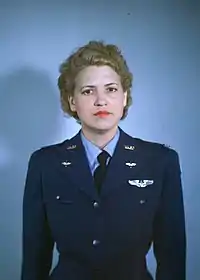
By 1952, approximately 40 percent of Americans had a television.[18] In his 1990 article, "Television's First Political Spot Ad Campaign: Eisenhower Answers America," author Stephen C. Wood wrote that the 1952 presidential election was the first to "render political television strategically".[19] Total media expenditure for the election is estimated to range from $2 million (equivalent to $20.4 million in 2021) to over $6 million (equivalent to $61.2 million in 2021).[19] The Eisenhower campaign launched a series of television commercials titled "Eisenhower Answers America."[20] BBDO was responsible for handling most of the advertising for Eisenhower's campaign.[20][21]
On September 30, 1952, Jacqueline Cochran,[22] a pilot, cosmetic business executive, and one of Eisenhower's campaign aides,[23] wrote to Roy O. Disney, co-founder of The Walt Disney Company, about a proposed advertisement which she had discussed with John Hay "Jock" Whitney.[lower-alpha 1] She speculated it could be "the greatest piece of propaganda in this whole campaign."[22] Two days later, she wrote to artist George L. Carlson about the animated cartoon, which she called "We Like Ike." Calling it the "most extraordinary one minute short," she told him that many people, including Paul G. Hoffman and Paul Helms were impressed by the idea. Helms had donated $1,000 (equivalent to $10,200 in 2021) for production of the advertisement.[25]
Because Disney was a union shop, its work rules prohibited any partisan political activity. The work for the advertisement was undertaken by unpaid volunteers outside working hours.[24] Two animated spots were produced by the Disney Studio staff.[26] Gil George and Paul Smith wrote the lyrics and the music.[26] The advertisement, initially called "We'll Take Ike", is also known as "I Like Ike"[27] and "Ike for President."[22]
Synopsis
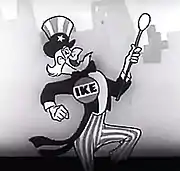
The animated 60-second commercial begins with a bouncing Ike campaign button as music plays in the background.[28] The clip segues to Uncle Sam as a drum major leading a circus elephant who holds an Ike banner with his trunk. The elephant is wearing a caricature of Eisenhower around its body, beating a drum with its tail.[28][29][30] Following the elephant is a large parade of people of different occupations,[30] about whom author Eric Burns writes, they "...marched in exaggerated fashion with the goofiest of facial expressions".[29] They included farmers, painters, police officers, businessmen, chefs, firefighters, nurses, cowboys, bankers, pipe-fitters, teachers, and housewives.[28][29] The visual then cuts to three donkeys, representing the Democratic Party. The music continues: "We don't want John or Dean or Harry / Let's do that big job right",[31] mocking John Sparkman, Secretary of State Dean Acheson, and President Harry S. Truman. As the parade continues, an unidentified man rides a donkey in shadows towards the left. The music interposes: "But Adlai goes the other way / We'll all go with Ike".[31] The Capitol building appears festooned with an Ike banner. A close-up of the Capitol dome and the rising sun turns into an Ike campaign button. The narrator concludes: "Now is the time for all good Americans to come to the aid of their country."[1][32]
Analysis
The advertisement used name repetition as the core of its catchy jingle:[33] the phrase "Ike for President" is repeated 19 times.[28] Author Victor Kamber called "Ike for President" a positive advertisement.[34] Author Thomas A. Hollihan wrote that its purpose was to generate name recognition and communicate that "Eisenhower enjoyed the support of people of different socioeconomic means."[30] Dennis W. Johnson said the main goal was to "drive home a consistent, simple message: 'I Like Ike' ", remarking that it "has to be one of the best presidential slogans ever created".[32] Paul Christiansen wrote that in "Ike for President", although Eisenhower's name receives a tonal emphasis, the word president is unstressed and is on the submediant and leading tone.[28] He speculated that this emphasizes Eisenhower the man and implies that his personality is greater than the presidency. The musical jingle begins in D major but changes to F major; its tempo is constant at 120 beats per minute.[28]

Christiansen contrasts "Ike for President" and the spiritual "All God's Chillun Got Wings"; he compares "You like Ike, I like Ike, everybody likes Ike" to "I got wings, you got wings, all God's chillun got wings".[35] He refers to the narrator's closing sentence as a "party-transcending appeal to voters",[1] and wrote:
... a vote for someone beside Eisenhower must be an antipatriotic betrayal. It is a call for all good Americans to come to the aid of 'their' party, after all. Good Americans belong to the Republican Party, it would seem. Voting for Eisenhower is presented here as a patriotic act that is for the good of the nation, leaving the converse proposition unspoken: are those voting for Stevenson unpatriotic?[1]
Aftermath
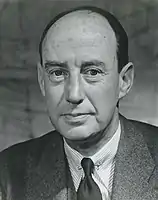
The "Ike for President" advertisement was sent to television stations in select American cities; the Eisenhower media plan was to broadcast it in targeted areas five to six times every night during the final two weeks of the campaign. Cochran paid over $2,700 (equivalent to $27,600 in 2021) to produce over 400 duplicates of the spot.[36] The Eisenhower campaign created other commercials featuring Eisenhower's wife Mamie; they were considered an indirect attack against the divorced Stevenson.[37][34] Reacting to the commercial, Stevenson said: "This isn't Ivory Soap versus Palmolive".[17] Later, he called "Ike for President" the worst thing he ever heard, and said that Eisenhower is "selling the presidency like cereal ... How can you talk seriously about issues with one-minute spots?"[38] Stevenson's campaign spent 95 percent of its television budget on broadcasting his 30-minute speeches.[39] Although the speeches attracted a huge audience, authors Edwin Diamond and Stephen Bates speculated that most Stevenson viewers were already committed to voting for him.[40] The Stevenson campaign created the "I Love the Gov" advertisement in response to "Ike for President".[41]
Eisenhower won the election, defeating Stevenson by a margin of 353 electoral votes.[42] Rosser Reeves, the advertising expert of the Eisenhower campaign, later said, the election "...was such a landslide that (the commercial) didn't make a goddamn bit of difference".[43] Roy O. Disney wrote to Cochran ten days after the election, saying that the "boys and girls all enjoyed working on the project and, of course, we are all very happy at the outcome of the election".[44] Time magazine ranked "Ike for President" eighth in its top-ten list of campaign advertisements.[45]
See also
Note
- Jacqueline Cochran's husband, Floyd Odlum, was a director of the Disney corporation.[24]
References
- Christiansen 2018 (a), p. 37.
- Whitney 2005, p. 1.
- Busch 2012, p. 55.
- Morris & Schwartz 1993, pp. 133, 140.
- Smith 1986, pp. 573–574.
- Pach 2017, p. 58.
- Ambrose 1983, p. 478.
- Pickett 2000, p. 35.
- Pickett 2000, p. 76.
- Ambrose 1983, pp. 28, 523.
- Christiansen 2018 (b), p. 45.
- Daniel 2000, pp. 396–397.
- Pusey 1956, pp. 6–20.
- SAGE Publications 2010, p. 399.
- Pusey 1956, p. 13.
- Lawrence 1952.
- Voss 2008, p. 186.
- Kamber 2003, p. 29.
- Wood 1990, p. 266.
- Wood 1990, pp. 265–270.
- Diamond & Bates 1992, p. 50.
- Christiansen 2018 (a), p. 32.
- Eisenhower Library.
- Rumbough 2013, p. 108.
- Christiansen 2018 (a), p. 33.
- Christiansen 2018 (a), pp. 33–34.
- Rumbough 2013, p. 109.
- Christiansen 2018 (a), p. 35.
- Burns 2010, p. 196.
- Hollihan 2009, p. 143.
- Christiansen 2018 (a), pp. 36–37.
- Johnson 2017, p. 67.
- Burton & Shea 2010, p. 3.
- Kamber 2003, p. 30.
- Christiansen 2018 (a), p. 38.
- Rumbough 2013, pp. 110–111.
- Diamond & Bates 1992, p. 59.
- Burns 2010, p. 197.
- Kamber 2003, pp. 30–31.
- Diamond & Bates 1992, p. 46.
- Christiansen 2018 (a), pp. 38–39.
- SAGE Publications 2010, p. 877.
- Kamber 2003, p. 31.
- Christiansen 2018 (a), p. 34.
- Rumbough 2013, p. 111.
Works cited
Books
- Ambrose, Stephen E. (1983). Eisenhower. Vol. One. Simon & Schuster. ISBN 978-0-671-44069-5. LCCN 83009892. OL 3167850M. Retrieved December 10, 2021 – via the Internet Archive.
- Burns, Eric (2010). Invasion of the Mind Snatchers – Television's Conquest of America in the Fifties. Temple University Press. ISBN 978-1-4399-0290-5. Retrieved February 21, 2022 – via Google Books.
- Burton, Michael John; Shea, Daniel M. (2010). Campaign Craft: The Strategies, Tactics, and Art of Political Campaign Management – The Strategies, Tactics, and Art of Political Campaign Management (2nd ed.). ABC-CLIO. ISBN 978-0-313-38344-1. Retrieved February 21, 2022 – via Google Books.
- Busch, Andrew (2012). Truman's Triumphs – The 1948 Election and the Making of Postwar America. University Press of Kansas. ISBN 978-0-7006-1866-8. LCCN 2012020593. OL 26379614M. Retrieved December 10, 2021 – via the Internet Archive.
- Diamond, Edwin; Bates, Stephen (1992). The Spot – The Rise of Political Advertising on Television. MIT Press. ISBN 978-0-262-54065-0. Retrieved February 21, 2022 – via Google Books.
- Hollihan, Thomas A. (2009). Uncivil Wars: Political Campaigns in a Media Age. St. Martin's Press. ISBN 978-0-312-47883-4. Retrieved February 21, 2022 – via the Internet Archive.
- Johnson, Dennis W. (2017). Democracy for Hire – A History of American Political Consulting. Oxford University Press. ISBN 978-0-19-027269-2. Retrieved February 21, 2022 – via Google Books.
- Kamber, Victor (2003). Poison Politics: Are Negative Campaigns Destroying Democracy?. Perseus Books Group. ISBN 978-0-7382-0872-5. Retrieved February 21, 2022 – via the Internet Archive.
- Pach, Chester J., ed. (2017). A Companion to Dwight D. Eisenhower. Wiley. ISBN 978-1-119-02733-1. Retrieved March 9, 2022 – via Google Books.
- Pickett, William B. (2000). Eisenhower Decides to Run: Presidential Politics and Cold War Strategy. Ivan R. Dee. ISBN 978-1-56663-325-3. Retrieved December 30, 2021 – via the Internet Archive.
- Pusey, Merlo J. (1956). Eisenhower – The President. Macmillan Publishers. Retrieved December 10, 2021 – via the Internet Archive.
- Rumbough, Stanley M. Jr. (2013). Citizens for Eisenhower. International Publishers. ISBN 978-0-615-86355-9. Retrieved February 21, 2022 – via the Internet Archive.
- Guide to U.S. Elections (6th ed.). SAGE Publications. 2010. ISBN 978-1-60426-536-1. LCCN 2009033938.
- Voss, Frederick (2008). Packaging Presidents: 200 Years of Campaigns & Candidates. Abraham Lincoln Presidential Library Foundation. ISBN 978-0-9799182-1-6. Retrieved February 21, 2022 – via the Internet Archive.
Journals and articles
- Christiansen, Paul (2018). "The Age of Innocence: 1952". Orchestrating Public Opinion: How Music Persuades in Television Political Ads for US Presidential Campaigns, 1952–2016. Amsterdam University Press. pp. 31–41. ISBN 978-94-6298-188-1. JSTOR j.ctv8pzcv5.5.
- Christiansen, Paul (2018). "Still Liking Ike: 1956". Orchestrating Public Opinion: How Music Persuades in Television Political Ads for US Presidential Campaigns, 1952–2016. Amsterdam University Press. pp. 42–46. ISBN 978-94-6298-188-1. JSTOR j.ctv8pzcv5.6.
- Daniel, Douglass K. (2000). "They Liked Ike: Pro-Eisenhower Publishers and His Decision to Run for President". Journalism & Mass Communication Quarterly. Association for Education in Journalism and Mass Communication. 77 (2): 393–404. doi:10.1177/107769900007700211. ISSN 1077-6990. S2CID 144712540.
- Lawrence, W. H. (June 12, 1952). "Eisenhower Nominated on the First Ballot; Senator Nixon Chosen as His Running Mate; General Pledges 'Total Victory' Crusade". The New York Times. Archived from the original on February 24, 2021. Retrieved September 13, 2021.
- Morris, Kenneth E.; Schwartz, Barry (1993). "Why They Liked Ike – Tradition, Crisis, and Heroic Leadership". The Sociological Quarterly. Midwest Sociological Society. 34 (1): 131–151. doi:10.1111/j.1533-8525.1993.tb00134.x. JSTOR 4121562.
- Smith, Tom W. (1986). "The Polls: The Most Admired Man and Woman". Public Opinion Quarterly. American Association for Public Opinion Research. 50 (4): 573–577. doi:10.1086/269005. JSTOR 2748760.
- Whitney, Gleaves (2005). "Eisenhower and D-Day". Hauenstein Center for Presidential Studies. Retrieved March 11, 2022.
{{cite web}}: CS1 maint: url-status (link) - Wood, Stephen C. (1990). "Television's First Political Spot Ad Campaign: Eisenhower Answers America". Presidential Studies Quarterly. Wiley. 20 (2): 265–283. JSTOR 27550614.
- "Jacqueline Cochran and the Women's Airforce Service Pilots (WASPs)". Dwight D. Eisenhower Presidential Library, Museum and Boyhood Home. Retrieved March 3, 2022.
{{cite web}}: CS1 maint: url-status (link)
Further reading
- Cotter, Cornelius P. (1983). "Eisenhower as Party Leader". Political Science Quarterly. Wiley. 98 (2): 255–283. doi:10.2307/2149418. JSTOR 2149418.
